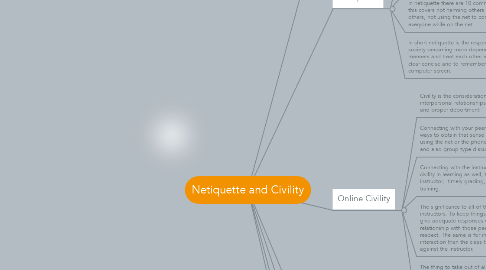Netiquette and Civility
by Jason Young


1. The relationship between netiquette and civility ultimately go hand in hand. No matter what we do in life whether it be online or not we still need to maintain a sense of humanity. Respect and communication are always key, just because you're online doesn't give you free reign to act how you want to. There is still a code as if you were talking to that person face to face. Even through text your words can cause damage and can belittle others. Together we all can make being online a time of fun and enjoyment through good etiquette and civility skills.
1.1. Define actions as necessary
2. Online Civility
2.1. Civility is the consideration of others in interpersonal relationships, manners, politeness, and proper deportment
2.2. Connecting with your peers is extremely important and some ways to obtain that sense of connection is face to face peer time, using the net or the phone to talk or text, feedback from peers and also group type discussions.
2.3. Connecting with the instructors is an important part to the civility in learning as well, this is timely feedback from your instructor, timely grading, and a certain amount of instructor training.
2.4. The significance to all of this is the connection between not only peers but also with your instructors. To keep things civil you have to be on a good level with all. If your peers forget or don't give adequate responses or don't take into consideration of your thoughts and ideas the relationship with those peers is going to be damaged and could lead to problems and lack of respect. The same is for instructors. If you get a paper with a poor grade or have poor face to face interaction then the class time is going to be one you may do poorly on or the student may retaliate against the instructor.
2.5. The thing to take out of all this is in order to be civil with peers and instructors you have to have that respect and etiquette while talking to that person, or emailing or texting it's all connected. You must have the communication skills to connect but also the mind set to keep everything on a good level. In the 40's and 50's til about the 80's everyone was polite and knew how to interact with one another. Technology has changed this and it's time to get back to basics and learn to communicate civilly and with proper etiquette.
3. Scheuermann, Larry, and Gary Taylor. "Netiquette." Internet Research 7.4 (1997): 269-73.
4. Netiquette
4.1. "Netiquette" is derived by merging the words "network" and "etiquette. This mean the politeness and communication on the net.
4.2. Ten commandments in computer ethics talks about remembering the people you interact with are human. To be cognizant of what you write and to properly cite and give credit where credit is due. Be careful what and how you say things, give back to the internet community, and summarize what you follow up.
4.3. In netiquette there are 10 commandments. To summarize them this covers not harming others on the net, not interfering with others, not using the net to commit crimes and having respect to everyone while on the net.
4.4. In short netiquette is the respect you show to others on the net. With this society becoming more dependent on the net it's imperative that we still use manners and treat each other with respect. Our communication needs to be clear concise and to remember we are all humans on the other side of that computer screen.
5. Intorduction
5.1. Netiquette and Civility is the relation between etiquette on the net and how to treat others while communicating on the net.
5.1.1. Project specifications
5.1.2. End User requirements
